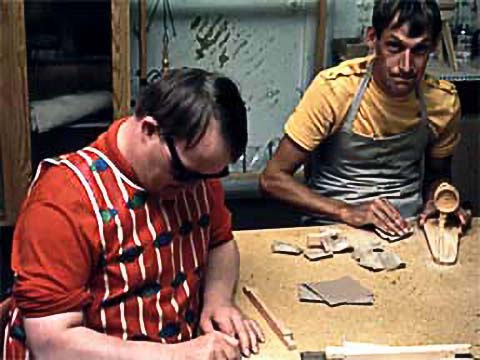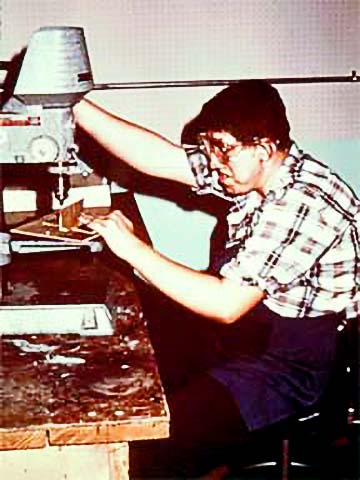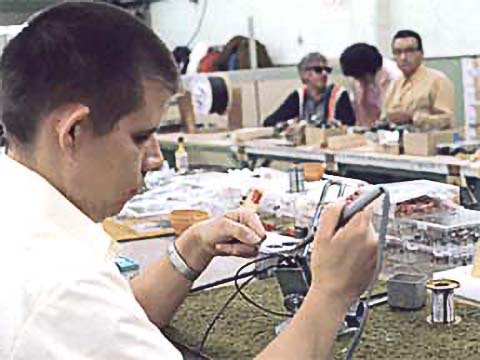Two Streams – Real Work and Sheltered Programs
By 1969, the President's Committee stressed the need for realism in the vocational objectives parents have for their children, and the role of education and training to prepare people to meet realistic objectives. Usually the phrase "let's be realistic" is a call to limit opportunities for people.
The PCMR, however, was pushing for increased recognition of the employment potential of people with developmental disabilities.
Realism must be the key to the education and training of people with developmental disabilities. They will have to enter a real world not truly made for them; get a real job that may be alien to their concepts of work; face up to real social and interpersonal situations that may not always be pleasant; handle real personal problems (money, transportation, living quarters, the like) that for us might be routine but for them are crisis-sized.

Photo courtesy William Bronston, M.D.
Education Preparing for the World of Work
Early in life, education and training must prepare them for the world of useful work. And it must prepare them for the world of useful living outside of work.
Parents should be encouraged to accept realistic vocational objectives for their children with developmental disabilities. To do this, it is necessary to inform not only parents, but also persons to whom parents might turn for counsel.
These professions should be provided with material dealing with the training and employment of people with developmental disabilities, with the emphasis placed on the innate value of all work whether skilled or unskilled.
The PCMR recommended developing curriculum guidelines to prepare people for work, preparing materials on work for people with disabilities themselves, and building on "new concepts of vocational education that bring students out of the classroom into work-a-day situations."

Photo courtesy William Bronston, M.D.
The Concepts of Job Redesign
The PCMR's other recommendations underscored the dual focus on sheltered environments and competitive work. They also give early support for the concepts of job redesign and modifications.
- Many more work experience centers with living facilities (made possible by the Vocational Education Amendments of 1986).
- Centralized contract procurement for workshops.
- Greater role for vocational education in meeting education and employment needs.
- At least 600 new sheltered workshops.
- More on-the-job training programs.
- More industry-wide training and employment projects that move beyond service occupations (laundries, hotel, motels, and restaurants).
- Training projects in broader job fields – data processing, electronics, merchandising, and the arts).
- Encourage employers to scale down their educational requirements for jobs.
- Encourage job redesign in both white and blue collar jobs.
- Do not pay less than prevailing wages in the area, provided people can perform the job satisfactorily.

Photo courtesy
William Bronston, M.D.
By 1972, some of the initial thinking about job redesign and on-the-job training introduced in the late 1960s were seen as trends. A monograph on "Mental Retardation and the Future" described approaches that would, in fact, become much more common, though in profoundly different ways:
The greatest impetus in increasing employment opportunities will probably be the use of job specifications which emphasize abilities. Jobs can be broken down into parts and new job descriptions written to fit the particular abilities of the [individual]. Also, increased awareness of the under-utilization of abilities among the retarded will overcome the tendency to place them in positions which do not fully realize their potential… During the next decade we will see the community assuming more of the responsibility for employment practices. Industry will provide imaginative leadership in redefining jobs which the retarded can perform, and will identify, if not actually provide, training appropriate to these jobs.

Photo courtesy William Bronston, M.D.
The emphasis on employment, however, applied primarily to those considered "mildly disabled." For many others, sheltered environments would be the rule.
It is not until the 1970s that the teaching and support strategies begin to emerge to support people with severe and multiple disabilities to enter the real world of real work. In the 1980s, substantial resources became available to implement supported employment approaches.
The sheltered workshop represents the major rehabilitation service with the most general application. Many mildly retarded adults can, with assistance, obtain employment. Others will require the service of a rehabilitation counselor. Still others will need further training prior to entering the competitive world. Few moderately retarded persons will independently obtain employment. In general, they will rely on sheltered workshop employment and/or training (PCMR 1969).

Photo courtesy William Bronston, M.D.
